NASA satellites showed that the huge glacier B-15A, which had an area of 2,500 square kilometers, broke up into three huge pieces
For the video segment documenting the movement of the glacier (on the NASA website)
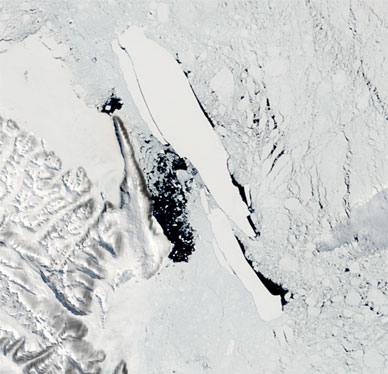
NASA satellites showed that the huge glacier B-15A, which had an area of 2,500 square kilometers, broke up into three huge pieces. For the past few years, this glacier has been named the largest floating bone on Earth. It got stuck near the Ross Islands, the area where the US McMurdo Research Station is located. The huge glacier threatened penguins who could not reach the open water and returned without providing food for their offspring. The excess ice also made it difficult to route ships to the station. B-15A is now located near Cape Andre.
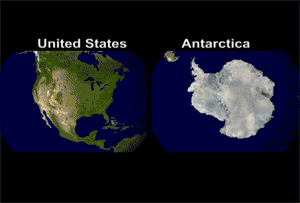
More evidence of global warming: The European Space Agency (ESA) reported that from satellite photographs it conducted, it appears that the B-15A glacier, which until recently was the largest glacier, has broken up into several small glaciers. Experts claim that the disintegration of the glacier in Antarctica is apparently a result of changes in the climate and the warming of the earth.
The Envisat satellite radar has been sensitive to light frequencies emanating from ice due to the continuous movement of the floating mountain since the beginning of the year. In recent images, the bottle-shaped glacier appears to have broken up into nine knife-blade-like pieces and a variety of smaller pieces on October 28-27.
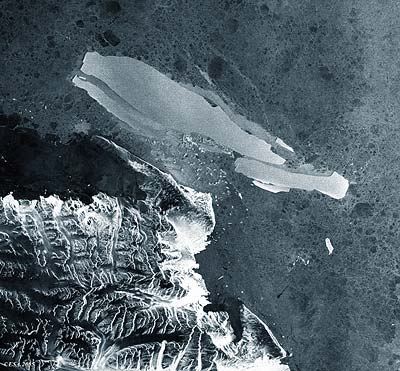
Beginning of disintegration, October 30, 2005
Before the breakup, the length of the glacier was 115 kilometers and its area, as mentioned, 2,500 square kilometers.
B-15A The flat glacier is moving in the area of Cape Ender, the northernmost corner of the Victoria coast, where the glacier actually ran aground and this led to stresses and bends within the glacier that caused it to disintegrate.
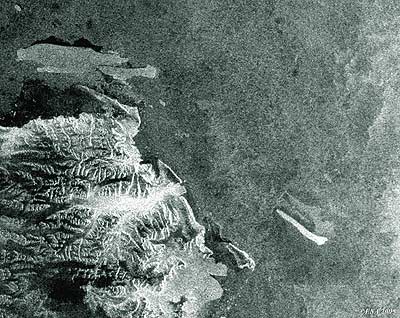
Pieces of ice drifting in the current, November 3, 2005
Glacier B-15A used to be part of a huge parent glacier, labeled B-15. The shape of the pieces - long knives made scientists estimate that the glacier split along lines of weakness within it. said Mark Drinkwater of the European Space Agency's Oceans and Ice Unit. The new glaciers will continue to be called the Hubble Glacier. The three island-sized glaciers were named B-15M, B-15N and B-15P.
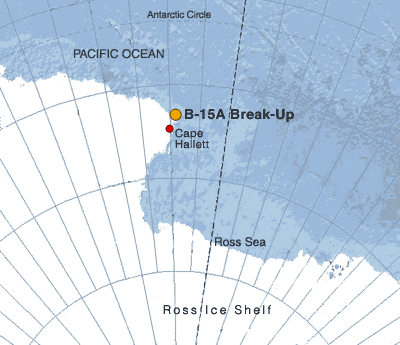
The location of the glacier
Researchers who closely monitor the condition of the glaciers on Earth and the height of the sea level, issue frequent warnings and warn of the dangers that may be caused by global warming and the subsequent melting of the glaciers. Recently, the American space agency, NASA, published satellite photographs that also demonstrate a significant decrease in the volume of glaciers in the last 25 years. The researchers compared photographs taken in 1979 and those taken more recently in the same place and discovered significant differences in the volume of the glaciers between the years.
These publications join many other observations that demonstrated and proved that in recent years the rate of glacier melting is on the rise. According to estimates, the Earth's temperature is expected to increase by 5 degrees Celsius in the next 50 years. The consequences of the warming are immediate: the melting of the glaciers, the rise of the sea level and danger to the coastal cities and beaches.
The disappearance of the glaciers is apparently related to global climatic changes resulting from air pollution and the greenhouse effect. As a result of trapping gases in the atmosphere, the heat of the sun's radiation is prevented from returning to space and trapping it in the earth.
The greenhouse effect results from a series of factors, the main of which is the emission of carbon dioxide into the atmosphere from vehicles and polluting industrial plants. The emission of carbon dioxide is joined by deforestation and in particular the rainforests, the destruction of the ozone layer, various types of air pollution including acid rain and smog and more.
Antarctica: the giant glacier changed direction and ran aground
The glacier, which is 160 km long, did not "behave" as the scientists expected. It collided with a different glacier than expected and now it poses a danger to the science stations there and to tens of thousands of penguins, who will probably starve to death.
Antarctica: the giant glacier changed direction and ran aground
21.1.2005
By: the scientist
The scientists have been watching him expectantly for some time. On the one hand, they were afraid of him and on the other hand, they hoped that he would be useful. Everyone was in awe of the giant glacier, B15-A, which floated slowly in the Antarctic on its 160 kilometers.
Now, it seems that the largest glacier in the world has run aground and that it poses a great danger to the penguin colonies, according to the hypotheses of the scientists in Antarctica. There are tens of thousands of penguins in the area, who may die of starvation.
Experts expected the giant B15A to collide with another glacier, in the area of the American McMurdo Science Station in Antarctica, at the end of last week. But the glacier was observed moving onto another glacier, 100 km long, at a distance of about 5 km from the land where it was feared that it would collide.
B15A has blocked the wind and water that cause flooding in the area during the akritic summer period, and cause piles of ice. American, Italian and New Zealand science stations in the area may lose their ability to work there. The glacier is at a transit point for ships expected to arrive in Antarctica soon, with fuel and food for the three stations.
Scientists hoped that the collision between the two glaciers would cause the glacier to move from the coast and out to sea, which would open up the shipping lane. It looks like it won't happen anymore.
